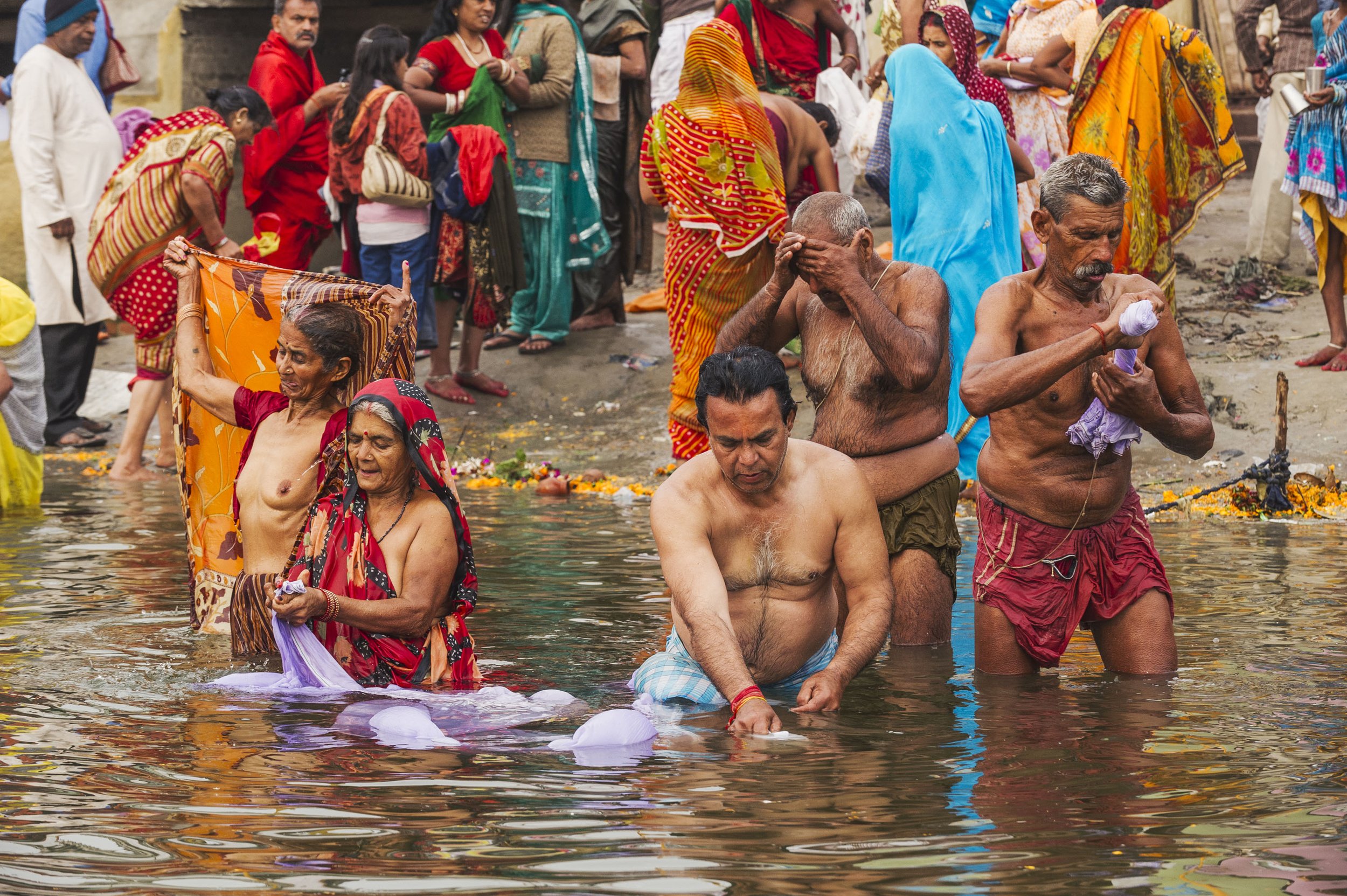India 2013
Varanasi, Uttar Pradesh

Varanasi (also known as Benares, o Banaras, Benaras, Kashi e Kasi) often referred to as the spiritual heart of India, is a city like no other. Situated on the left bank of the sacred Ganges River in the state of Uttar Pradesh, Varanasi is a place of profound spirituality, ancient traditions, and vibrant culture.
Varanasi is known for its history and mythology, as it is one of the oldest continuously inhabited cities in the world. According to Hindu beliefs, Varanasi is the cosmic center of the universe and the holiest of the seven sacred cities in Hinduism. The name derives from the confluence of the Varuna and Assi rivers, which flow into the Ganges, representing the city's sacred significance.
The city of Varanasi is filled with a myriad of colors, sounds, and smells, and life unfolds through a mesmerizing tapestry of rituals, ceremonies, and daily activities. The city's labyrinthine streets are filled with ancient temples, vibrant markets, and bustling ghats, where believers come together to perform sacred rites, oer prayers, and take holy baths in the holy waters of the Ganges.
At the heart of Varanasi lies the iconic Dashashwamedh Ghat, where the Ganga Aarti, a mesmerizing ritual of worship, takes place every evening, illuminating the riverbanks with the glow of a thousand oil lamps and the sound of devotional hymns.
Varanasi is also renowned for its rich cultural heritage and artistic traditions. Classical music and dance performances, as well as exquisite handloom textiles and intricate silk sarees, are all part of what makes the city a hub of creativity and artistic expression.
But beyond its tangible beauty lies the intangible essence of Varanasi – a spiritual energy that permeates every corner of the city, drawing seekers, pilgrims, and travelers from around the world in search of enlightenment, solace, and inner peace.
In Varanasi, time seems to stand still as ancient rituals and timeless traditions continue to unfold amidst the ever-changing landscape of modernity. It is a city where the past merges seamlessly with the present, where the sacred and the mundane coexist in perfect harmony, and where every moment is infused with the magic of eternity.
The city of ghat
The ghats of Varanasi are the heart of this ancient city, where life unfolds against the backdrop of the sacred Ganges River. The western bank of the river is traversed by these stone steps, which lead down to the water's edge and create a mesmerizing tableau of spirituality, tradition, and daily life.
The unique character and significance of each ghat in Varanasi oer a glimpse into the city's rich cultural heritage and spiritual legacy. From the iconic Dashashwamedh Ghat, where the elaborate Ganga Aarti ceremony takes place every evening, to the tranquil Assi Ghat, where devotees gather for sunrise rituals and yoga practices, each ghat has its own story to tell.
As the sun rises over the Ganges, the ghats come alive with activities. Pilgrims and devotees descend the steps to perform sacred rites, oer prayers, and take holy baths in the river's purifying waters. Sadhus and sages, draped in saron robes, meditate in quiet contemplation, while vendors hawk their wares and boatmen ply their trade along the riverbanks.
But the ghats are more than just places of religious significance; they are also vibrant social hubs where locals and visitors alike come to socialize, relax, and connect with one another. From lively boat rides along the river to leisurely walks along the ghats, there is a sense of camaraderie and community that permeates the air.
As the evening descends upon Varanasi, the ghats take on a magical glow, illuminated by the flickering flames of oil lamps and the sound of devotional chants filling the air. It is a time of reflection, reverence, and spiritual renewal, as the timeless rituals of the Ganga Aarti unfold amidst the ancient stones of the ghats.
In Varanasi, the ghats are more than just stone steps leading to the river; they are living, breathing symbols of the city's enduring spirit and timeless charm. They are places of pilgrimage, prayer, and profound connection, where the sacred and the mundane intersect in a dance of life along the sacred waters of the Ganges.
Varanasi City of Ghat
Varanasi City of Ghat
Varanasi City of Ghat
Varanasi City of Ghat
Varanasi City of Ghat
Varanasi City of Ghat
Varanasi City of Ghat
Varanasi City of Ghat
Varanasi City of Ghat
Varanasi City of Ghat
Varanasi City of Ghat
Varanasi City of Ghat
Varanasi City of Ghat
Varanasi City of Ghat
Varanasi City of Ghat
Varanasi City of Ghat
Varanasi City of Ghat
Varanasi City of Ghat
Varanasi City of Ghat
Varanasi City of Ghat
Varanasi City of Ghat
Varanasi City of Ghat
v
Varanasi City of Ghat
Varanasi City of Ghat
Varanasi City of Ghat
Varanasi City of Ghat
Varanasi City of Ghat
Varanasi City of Ghat
Varanasi City of Ghat
Varanasi City of Ghat
Varanasi City of Ghat
Varanasi City of Ghat
Varanasi City of Ghat
Varanasi City of Ghat
Ganga Aarti
Hinduism is a religion of complex and symbolic rituals, incorporating plays of light, color, and bodily movements that represent a careful aesthetic and artistic pursuit of great cultural value.
For the Aarti ritual, a metal tray is typically used, adorned with flowers, upon which a metal or terracotta lamp is placed, filled with clarified butter, called Ghee, or oil, to fuel the flame that burns a cotton wick. In particular cases, camphor, a white waxy substance with a strong aromatic odor, is used instead of cotton. This variation holds a precise symbolic significance: camphor burns without leaving any residue, symbolizing the ego, which, once spiritual realization is attained, disappears without a trace.
The Ganga Aarti is performed on a stage by a group of young Pandits (Hindu priests) dressed in saffron-colored attire. During the ceremony, they move slowly with precise movements and gestures, offering the lamp to the deity seven times, then turning to the devotees in the same manner before returning to the deity. They then make four additional rounds toward the deity's feet, two at the navel, three at the face, and seven more rounds around the entire figure. Meanwhile, believers cup their hands over the fire, bringing the purifying force of the flame to their foreheads, while the lamp is circulated among the crowd.
The Aarti ceremony is accompanied by religious Bhajan chants, prayer texts set to simple melodies, with the constant sound of ceremonial bells, gongs, and drums reverberating in the air. Additionally, the sound of sacred conch shells, which have always held a significant place in Hindu mythology as one of Vishnu's four weapons that harnessed the primordial sound of creation, is used in the ceremony to disperse negative energies and ward off evil forces.
This perfect blend, coupled with the fragrant scent of sandalwood, creates a magical and enchanting atmosphere, imparting a sense of harmony, joy, and reassurance to visitors.
Although the Ganga Aarti is performed twice daily, it still attracts many tourists, and finding a place on the steps can be challenging. The ceremony itself lasts about half an hour, but it is advisable to arrive early to ensure participation. Alternatively, one can watch comfortably by purchasing a boat ticket and viewing it directly on the Ganges River or from the terrace of a nearby commercial establishment.
Ganga Aarti in Varanasi
Ganga Aarti in Varanasi
Ganga Aarti in Varanasi
Ganga Aarti in Varanasi
Ganga Aarti in Varanasi
Ganga Aarti in Varanasi
Ganga Aarti in Varanasi
Ganga Aarti in Varanasi
Varanasi and Muslims
Muslims have been an integral part of the cultural fabric of Varanasi, adding to the city's rich diversity and vibrant tapestry of traditions. As one of the oldest continuously inhabited cities in the world, Varanasi has long been a melting pot of cultures, religions, and communities, and Muslims have played a significant role in shaping its history and heritage.
In Varanasi, Muslims coexist harmoniously with Hindus and people of other faiths, contributing to the city's unique multicultural identity. While Hinduism is the predominant religion in Varanasi, Islam has a strong presence, with mosques and Islamic institutions scattered throughout the city.
Muslims in Varanasi
Muslims in Varanasi
Muslims in Varanasi
Muslims in Varanasi
Muslims in Varanasi
Muslims in Varanasi
Muslims in Varanasi
Muslims in Varanasi



















































